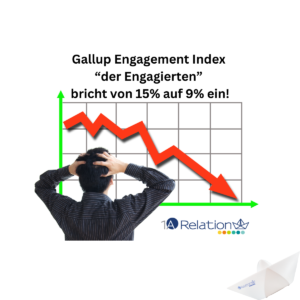In times of advancing digital transformation of the economy and increasing competitive intensity for almost all industries, individually tailored customer communication is increasingly becoming the focus of promising customer relationship management. Placing the customer at the center of all corporate activities is nothing new here. In fact, the aspect of “customer orientation” is already firmly anchored in most corporate philosophies. But what does customer orientation mean in concrete terms with regard to the design of a targeted and adapted communications policy? For some years now, it has been common practice to focus even more strongly on the needs of customers and to design precisely tailored messages and recommendations. It is therefore not surprising that the approach of “personalization” has now become firmly established in marketing measures and the associated customer communication. Personalization can be found, for example, in addressing customers by name (e.g., in e-mail newsletters and push messages), and companies are increasingly looking to make reference to the buying habits of their customers. At first glance, this approach sounds very sensible and purposeful. However, practice and science now agree that such personalization is often not yet sufficient and, moreover, in many cases is not even implemented properly. On the contrary, it can be observed that in many companies there is sufficient customer data, but it is not really being used effectively. So-called “data silos” (a distributed storage of data in the company without linking them to each other) make a targeted implementation just as difficult as a lack of awareness for the correct handling of technologies. However, advancing digitization and the associated technological developments, such as artificial intelligence, AI, offer companies a great deal of potential that often remains untapped. One such potential lies, for example, in what is known as “hyperpersonalization,” which is currently the strongest further development stage of personalization. This approach is characterized by the real-time-driven and context-relevant use of browsing and behavioral data to design individual customer communications. The focus here is on the use of large volumes of data (“big data”) and the targeted use of AI to implement high-level personalization. The overriding goal is and remains to further increase the relevance of marketing messages and, above all, to tailor them even more closely to the context of the individual. This presents an opportunity to significantly optimize the individual customer experience and maximize the benefit of communication messages for the individual customer.
Hyperpersonalization as a decision-making aid for the customer

From the customer’s perspective, hyperpersonalization starts with the classic purchase decision process and aims to simplify the phases of searching for information and evaluating alternatives. In times of today’s “always-on” mentality, every online user is confronted with a huge amount of information every day. To illustrate this, a rough overview of the amount of data generated online in 60 seconds on average in 2021 is sufficient: around 197.6 million emails were sent, 500 hours of video content were published on YouTube, 695,000 Stories were shared on Instagram, and nearly $1.6 billion in revenue was generated – per minute (see here: https://www.weforum.org/agenda/2021/08/one-minute-internet-web-social-media-technology-online/). With this amount of information, it’s not really surprising that users and thus (potential) customers can quickly become overwhelmed as to what is really relevant for them now. The term “information overload” has become established for this overload, which is rooted in the cognitive capacities of the human brain. Like a computer, the human brain has only a limited processing capacity. This means that not all the information with which an individual is confronted can actually be absorbed and processed. Once the capacity limit is reached, a feeling of being overwhelmed sets in relatively quickly, which can result in a stress reaction for the individual. At the same time, this negative feeling makes decision-making in a purchasing process more difficult, so that it is not uncommon for resignation to set in. From the company’s perspective, a “battle” for the attention of the (potential) customer arises at the same time. The human attention span today is very short at around 8 seconds and comparable to that of a goldfish. For the practice, it is therefore crucial and a central challenge to identify the right moment of address for the individual customer and to deliver a timely message that has meaning for the individual. Those moments become “moments of truth.” To take this process to the extreme, the company should anticipate the customer’s needs before they are even articulated. A proactive approach is based, for example, on a continuous learning process through the use of AI (especially machine learning) and thus forms the entry point to a customer experience that should remain in the customer’s memory in the long term.
First approaches to the use of hyperpersonalization in practice
To date, some companies are already making efforts to advance their personalization approaches in the direction of hyperpersonalization and thus minimize the information overload described, for example. However, it must also be noted that not all potential has yet been fully exploited. Amazon” is and will certainly remain a pioneer in the e-commerce context. For years, the company has relied on its own recommendation system, which is based on data analysis of customer click and purchase behavior. However, there remains further optimization potential here as well (e.g., in the direction of increasing individual relevance). Streaming providers such as Netflix and Spotify rely on individually tailored playlists or teaser images in their user approach, for example, although the real-time factor and contextual aspects are also to be incorporated even more strongly here in the future. The U.S. company Starbucks, which specializes in coffee products, already offers a location-based customer approach via push messages in its app and refers directly to nearby stores, for example, where a coffee speciality ordered via the app can be picked up. This is combined with individual product recommendations.
Eight factors for successful implementation of hyperpersonalized customer communication
However, to make the hyperpersonalization approach more tangible overall, it is worth taking a look at the essential success factors for targeted implementation. First of all, it should be noted that hyperpersonalization is currently the strongest form of the “segment-of-one” approach to addressing individual customers and relies on the deepest customer insights to achieve a high degree of customer orientation. The development in the direction of data-driven real-time marketing should therefore be based on the following factors:

- Context sensitivity: This aspect describes how individual communication and marketing messages are tailored to the context of the respective customer. For this purpose, situational factors (such as the current season) should be taken into account, as should life events that have just taken place (e.g., a move or a wedding). Context sensitivity ultimately results in better needs orientation of the respective communication measures.
- Relevance: Linked to the current context of the individual customer, an individual benefit or added value should be created at the same time. This can be, for example, an increase in efficiency, satisfaction of needs, or cost savings. The aim is to make the customer experience meaningful in the short and, above all, long term.
- Timing: In addition to the communication content, the timing of the approach also plays a decisive role. Every customer has an individual attention span. For companies, the challenge is now to address the customer as much as possible when personal interest is at its highest, e.g., at a specific time of day or time of day. This favors the development toward communication that is as real-time-driven as possible.
- Proactivity: As described above, needs should ideally be anticipated and therefore forward-looking communication should be practiced. The “predictive analytics” approach offers the possibility of recognizing certain behavior patterns through the use of AI and thus making a prediction about future behavior.
- Automation: In order to implement hyperpersonalization in a promising way, processes must be designed efficiently and the effectiveness of decisions optimized. Automation should trigger a continuous learning process based on existing data, in which, for example, certain behavior patterns act as triggers for communication measures. From the company’s point of view, the right software support is crucial here.
- Omni-channel: Customers today use a variety of channels to contact companies. Accordingly, the application of hyperpersonalization should enable smooth switching between channels – both offline and online. This results in a “Seamless Customer Experience”.
- Frequency: The communication effect also depends on the number of repetitions in order to remain “in the mind” of the customer. For this reason, the relevant messages should be played out in an individually coordinated rhythm that is not intrusive or distracting. This aspect is also directly related to the proactivity described above.
- Speed: In the sense of “real-time marketing”, a hyper-personalized approach does not allow any delay. Speed of implementation is essential. Therefore, the following questions must be answered: How quickly can the available data be collected and processed? How quickly can customer behavior be responded to appropriately?
If all these factors are combined and implemented accordingly, the potential of hyperpersonalized addressing can be almost fully exploited. However, legal conditions, such as those relating to data collection and processing, must not be disregarded under any circumstances. As a rule, consent is required for data use, so the added value for the customer should be communicated transparently and any data protection concerns should be taken into account. In the future, it will be important to further convince both the company and the customer of the importance of hyperpersonalized communication and to alleviate concerns. Then it will also be possible to measure positive effects on customer behavior. The technological prerequisites for implementing hyperpersonalization are already in place, they just need to be used much more consciously and purposefully in the future.
Author:

Short vita Nora Kern
As a research assistant at the Chair of Marketing and Electronic Services at the University of Koblenz, Nora Kern is working on her doctoral thesis on the use of hyperpersonalization in e-commerce. Before that, she did her master’s degree in information management at the University of Koblenz.












